Pine (Pinus)
Plant Health Problems
Diseases caused by Fungi:
Dieback, Diplodia tip blight, Sphaeropsis pinea.
This can be a destructive and devastating disease of pines, especially two- and three-needled species. Austrian, mugho, red, and Scots pine are very susceptible although many other species of pine are also affected, especially when growing under conditions of stress. After injury or stress this pathogen can invade, causing a reduction of tip growth on two- and three-needled pines for several years, and branch dieback. The needles are short and turn brown prematurely, usually showing the small black fruiting pustules at or below the sheath.
Control requires sanitary and cultural methods. Prune and remove blighted twigs, branches, and cones during dry weather in autumn to reduce the amount of fungus available to infect new growth in the spring. Fertilize and control insect infestations, and water during periods of drought. Fungicide applications can supplement these control methods. Among the compounds registered for use in Connecticut are copper sulphate pentahydrate, mancozeb, and thiophanate-methyl. Consult the label for dosage rates and safety precautions. For more information, see the fact sheet on Diplodia Tip Blight.
Needlecast, Canavirgella banfieldii.This needlecast is a disease of Eastern white pine and Macedonian white pine. Infected trees appear reddish-brown in late July and early August, and symptoms are usually confined to current-season needles. In the spring, infected needles curl and fade to tan or gray. Not all needles in a group are infected. The bases of the needles usually remain green and the needles often remain attached to the tree.
Control requires sanitary and cultural methods. Prune and remove twigs and branches with infected needles during dry weather in autumn to reduce the amount of fungus available the next season. Tree vigor should be maintained. Fertilize and control insect infestations, and water during periods of drought. Because of the newness of this disease to Connecticut, specific fungicides are not labeled for use. For more information, see the fact sheet on Canavirgella Needlecast of Pine: New Needlecast Disease for Connecticut.
Needle rust, Coleosporium solidaginis.
Rusty-colored needles typical of many similar needle rusts on two- and three-needled pines. The disease is started by spores formed on goldenrod. It is common on pitch, red, and jack pine. In spring, small white tubes which discharge orange spores appear on the needles. These spores infect the alternate hosts, chiefly aster and goldenrod, where the fungus can maintain itself indefinitely. This pathogen usually is of little importance on old trees but can weaken young stock considerably.
There are no controls, except reducing the amount of goldenrod in the area.
White-pine blister rust, Cronartium ribicola.
This is a disease of historical significance throughout the Northeast. Although this disease usually passes unnoticed until the second or third year after infection, the fungus enters young needles in the fall and works its way down the needle into the wood. The infected wood swells and has a yellow or orange tinge. In spring or early summer, drops of clear orange liquid appear on infected areas which attract insects; these pycnia later fall out leaving dark scars. The following year white blisters push through the bark. These discharge orange aeciospores that are carried by wind to infect currant, gooseberry, and wild Ribes leaves, where the spores that infect the pine needles are produced. The part of the tree beyond the canker dies if the canker extends around the trunk.
Control has been successful where all Ribes within 900 feet of white pines have been removed. The European black currant and gooseberry are more susceptible than the ordinary red currant which may be planted not closer than 400 feet from white pine. The ban on planting Ribes in Connecticut has now been removed although importation and planting of Ribes are still banned in many New England states.
Pitch canker, Fusarium lateritium.
Infection occurs through wounds from insect activities, weather damage, and mechanical injuries. Infected tissues have excessive resin flow associated with sunken, discolored lesions which girdle twigs, branches, and trunks. The diseased bark appears dark red and the wood underneath is also discolored. Shoot and branch dieback is usually most obvious from late autumn to early spring. Needles may be glued together from excessive resin.
Control requires sanitary and cultural methods. Prune and remove twigs and branches with infections during dry weather in autumn to reduce the amount of fungus available the next season. Tree vigor should be maintained. Fertilize and control insect infestations, and water during periods of drought.
Red-banded needle blight, Mycosphaerella pini (Septoria septospora).
Austrian pines are particularly susceptible to this fungus which causes water-soaked spots or bands on the needles anytime from spring to fall. The bands turn yellow to reddish-brown and there are sharp lines that mark the transition from green to discolored tissues. Some swelling may occur in symptomatic portions of the needles, and needle bases usually remain green. Small black fruiting bodies of the fungus break through the epidermis of the infected tissue and diseased needles drop prematurely.
Rake and remove fallen needles as much as possible to remove the source of infection. Fertilize trees in the spring and water during drought to maintain tree vigor.
Blue stain, Ophiostoma spp.
These pathogens are carried by bark beetles, and infect the vascular system of pines, causing blue streaks in the wood, which can usually be seen by peeling away the bark.
There are no effective chemical controls.
Sooty mold, Dimerosporium spp.
Needles and bark of certain branches appear black. Sometimes one whole side of a tree is affected. The fungus is entirely superficial and grows on honeydew left by aphids or some scale insects. There is no real injury to the tree.
The remedy consists of controlling the insects.
Diseases caused by Nematodes:
Pinewood nematodes, Bursaphelenchus xylophilus.
A nematode parasite of conifers which is carried from tree to tree by beetle vectors. A single Cerambicid beetle may carry up to 175,000 larvae. Nematodes enter the tree during beetle maturation feeding or oviposition, reproduce in the vascular tissue and cause wilt symptoms. Trees under stress are most attractive to beetles and susceptible to nematodes, and can be killed as quickly as 40 days, but more commonly within two years. The pinewood nematode is the most important forest pest in Japan, responsible for killing 8 million trees in 1978 alone. In the U.S., losses tend to be limited to ornamental Scotch, Austrian and Japanese black pines, especially when associated with salt, drought, or other stresses.
Sanitation (the removal of dead, beetle-infested trees), fertilizing, irrigating, and increasing tree vigor are the most effective ways of dealing with this nematode in the U.S.
Diseases caused by Physiological/Environmental Factors:
Needle blight, cause unknown.
This trouble is characteristic of white pines. Needles turn reddish-brown more or less at the tips and give the tree a scorched appearance. No fungus has been found associated with this trouble, but wind, sun, and air pollution appear to be partially responsible for the "burning." Some trees seem to blight every year; others occasionally.
Insect Problems
Aphids.
There are several aphids that feed on the branches of various species of pine. Any of these aphids can be controlled by spraying with acephate or insecticidal soap, which are among the compounds registered for use against this pest in Connecticut. Imidacloprid can be applied as a systemic to be taken up by roots. Consult the labels for dosage rates and safety precautions.
European pine shoot moth, Rhyacionia buoliana.
This insect is a serious pest of red and Scotch pine and is known to infest other pines. The larva feeds on buds and tunnels in new shoots. Terminal buds are killed and lateral shoots become leaders. This insect also feeds on the outside of new shoots which make them appear crooked near the tips, a condition called "bayonet growth." The larva overwinters in the buds and pupates in its burrow about June 1. The moth emerges in late June and has a wingspread of about 2/3". The forewings are reddish brown, crossed by two whitish bands near the tips. The eggs are laid on the twigs near the terminal buds. The larva is brown with a black head and reaches a length of about 5/8" when mature. There is one generation each year.
Some degree of control may be obtained by cutting off and burning, if allowed, the infested tips in late winter. Imidacloprid, which is among the compounds registered for control of this pest in Connecticut, applied as a systemic to be taken up by the roots also controls shoot boring caterpillars. Consult the label for dosage rates and safety precautions.
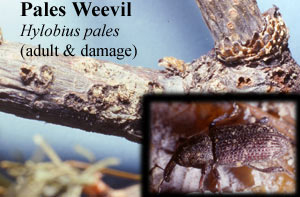 Pales weevil, Hylobius pales.
Pales weevil, Hylobius pales.
This weevil or snout beetle has the reputation of chewing the bark from the trunk and twigs of seedling pines and from the lower branches of older trees. "Flagged" twigs result, recognizable from the girdled bark at the base of these twigs. This insect may injure young trees if they are planted where coniferous trees have recently been cut, since larvae develop in recently cut stumps. Cut stumps should be sprayed with permethrin, which is among the compounds registered for control of this pest in Connecticut, to prevent successful adult egg laying. Consult the label for dosage rates and safety precautions. Thinning of pine stands rather than clear-cutting may also reduce the hazard of damage. Freshly sawed pine lumber should not be stored near young pine stands because it attracts weevils which later damage living trees.
Pine bark adelgid, Pineus strobi.
This adelgid infests white pine and is easily recognized by white cottony egg masses at the base of the needle clusters and by white flocculent patches, which are colonies of brown adelgids covered with wax secretion, on the trunks, base, and undersides of the larger branches. Although pine bark adelgid is usually harmless to large naturally occurring trees, it often severely weakens and kills seedlings in nurseries and ornamental plantings. There are several generations each season. Spraying with insecticidal soap, which is among the compounds registered for use against this pest in Connecticut, early in May can control crawlers of the first generation. A later treatment may be necessary if the infestation persists. Imidacloprid may be effective as a soil-applied systemic. Consult the labels for dosage rates and safety precautions.
Pine bark beetles.
There are several small bark beetles that commonly breed in the living bark of stumps, injured, or dying pine trees. Some of the more important species are the black turpentine beetle, the red turpentine beetle, the coarse writing bark beetle, and the pine bark beetle. Keeping living trees in good condition, especially by irrigating deeply during drought periods and prompt destruction of infested pines should reduce damage by this pest.
Pine needle scale, Chionaspis pinifoliae.
This is a white pear-shaped scale that infests the needles of various species and varieties of pine, fir, spruce, hemlock and Douglas fir. It is an especially serious pest of mugho pines growing in sheltered places. On other pines, there exists great genetic variation in susceptibility, so removal of heavily infested individual trees can help reduce problems with this scale. There are two generations each season and the insect overwinters as eggs underneath the old shells. The eggs hatch in late May; the young crawl about for a few hours then settle down, begin feeding, and secrete the wax that forms the shells. Early in July, the first generation matures and eggs for the second generation are formed under the shells. These hatch later in July and August. The second generation matures and forms eggs the first half of October. Spraying with malathion or ultrafine oil, which is among the compounds registered for use against this pest in Connecticut, about June 1 and again August 25 should control the young crawlers. Alternatively, spray with ultrafine oil in early April to suffocate overwintering eggs. To detect crawler activity, wrap black tape coated with Vaseline around small branches. Consult the labels for dosage rates and safety precautions.
Pine twig gall scale, Matsucoccus gallicolus.
This scale attacks several species of pines. Ornamental plantings of pitch pine are often severely weakened or killed by this scale. It has a single generation per year and overwinters as eggs. Young nymphs hatch and settle on the developing new twig growth in spring. They become enveloped by swellings of the bark and, therefore, are very inconspicuous until trees are heavily infested. Control by use of insecticides has not been successful and no effective natural enemies are known.
Pine webworms, Tetralopha robustella and T. melanugrammos.
Seedlings of red pine and white pine are sometimes infested with caterpillars that web together the leaves and frass, live in tubes within the mass, and feed on the needles. Some of these frass balls are globular and 2" or less in diameter, other are more elongate. Little is known of their life histories. If these insects become pests, spray with carbaryl, malathion, spinosad or Bacillus thuringiensis var kurstaki, which are among the compounds registered for control of this pest in Connecticut. Consult the labels for dosage rates and safety precautions.
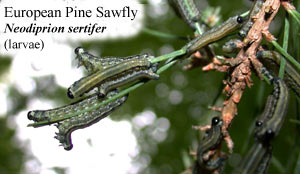 Pine sawflies.
Pine sawflies.
There are several species of pine feeding sawflies in Connecticut. The larvae devour the needles, sometimes defoliating the trees. The introduced pine sawfly, Diprion similis, has brown and green-striped and mottled larvae. The white pine sawfly, Neodiprion pinetum, has whitish larvae with black spots and black head. The redheaded pine sawfly, Neodiprion lecontei, has yellow larvae with black spots and red head, which feed on white, red, and mugho pines. Another species feeds on the pitch pine, while a larger species webs together the 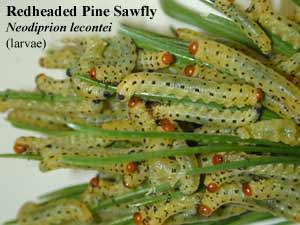 needles and its frass to make a nest, in which it lives and feeds, on Austrian pine. Carbaryl and spinosad, which are among the compounds registered for use against this pest in Connecticut, can be used to control the feeding larvae. Consult the labels for dosage rates and safety precautions.
needles and its frass to make a nest, in which it lives and feeds, on Austrian pine. Carbaryl and spinosad, which are among the compounds registered for use against this pest in Connecticut, can be used to control the feeding larvae. Consult the labels for dosage rates and safety precautions.
Pine spittlebug, Aphrophora parallela.
The immature stages of this insect develop in a froth mass or "spittle ball" on the twigs of different species of pine. These froth masses are from 1/2 - 3/4" in diameter and are usually near the tips of the twigs. The adult is gray-brown and about 1/2" long. Spittlebugs can be controlled by applying imidacloprid, which is among the compounds registered for control of this pest in Connecticut, as a systemic to be taken up by the roots. Consult the label for dosage rates and safety precautions.
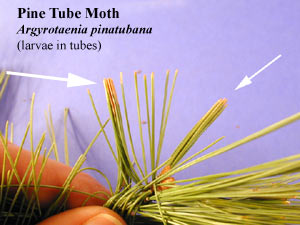 Pine tube moth, Argyrotaenia pinatubana.
Pine tube moth, Argyrotaenia pinatubana.
The larva of this moth webs the pine needles together to form a tube or case in which it lives and devours the terminal third of the needles. The larva is pale green with a light brown head, and is about 1/3" long. The moth has a wing spread of slightly more than half an inch, and the forewings are rust-red, crossed by two oblique parallel paler bands. The tube usually contains about 15 needles fastened together with silk threads. There is probably one generation each year. Natural enemies usually control this insect. Diazinon, Bacillus thuringiensis var. kurstaki, or spinosad are among the compounds registered for control of this pest in Connecticut and can be sprayed when needed. Consult the labels for dosage rates and safety precautions.
Red pine scale, Matsucoccus matsumurae.
This introduced insect, known also as M. resinosae, is a serious pest of red pine in plantations, ornamental plantings and nurseries. Cold winter temperatures have limited the northward spread of this insect into the natural stands of red pine. The scale has two generations per year and prefers to feed beneath bark flakes on the three-year-old growth in the lower part of the crown. Crawlers are most abundant in early June and late August. White cottony egg masses and cocoons of males often occur in large numbers on the undersides of branches in May and August when scale densities are high. Foliage of infested branches turns from olive green to yellow to red within a year or two and trees often die within five years. Control by use of insecticides has not been successful and natural enemies are ineffective.
White grubs.
In forest nurseries, the roots of pine seedlings and transplants are sometimes eaten by white grubs. See Lawns, oriental beetle.
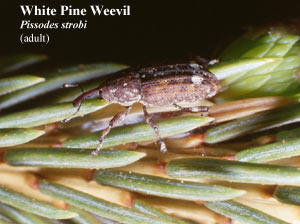 White pine weevil, Pissodes strobi.
White pine weevil, Pissodes strobi.
This is the insect that kills the leaders of white pine, and is perhaps the most serious pest of white pine at the present time. The adult beetles overwinter under dead bark, stones and wherever they may find protection in woodland areas, and appear on the trees in April. During May, they lay eggs in punctures in the bark of the leaders and the grubs feed under the bark, often girdling them so they wilt and die in July. Mature grubs make cells in the wood of the leader to pupate. The beetles begin to emerge in late July and continue into September. Winter is passed as an adult. There is one generation each year. The 1/4" long adult is a reddish-brown weevil with white spots on the rear of the wing covers. Seedlings planted in shade are seldom injured, but those in sunny situations are infested.

